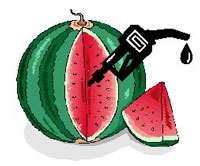 Watermelons… that tasty summertime treat… could be the next feedstock for the green fuel ethanol.
Watermelons… that tasty summertime treat… could be the next feedstock for the green fuel ethanol.
We’ve told you previously about how the National Watermelon Association has been pushing the idea of the fruit being used for ethanol (see our posts from May 20, 2009 and January 7, 2008). Now, it looks like there’s some research to back up that idea.
Wayne W. Fish, Benny D. Bruton and Vincent M. Russo have published this paper in the latest edition of Biotechnology for Biofuels showing how the melons that aren’t good enough for grocery stores might be just fine for the gas pumps:
Two economic factors make watermelon worthy of consideration as a feedstock for ethanol biofuel production. First, about 20% of each annual watermelon crop is left in the field because of surface blemishes or because they are misshapen; currently these are lost to growers as a source of revenue. Second, the neutraceutical value of lycopene and L-citrulline obtained from watermelon is at a threshold whereby watermelon could serve as starting material to extract and manufacture these products. Processing of watermelons to produce lycopene and L-citrulline, yields a waste stream of watermelon juice at the rate of over 500 L/t of watermelons. Since watermelon juice contains 7 to 10% (w/v) directly fermentable sugars and 15 to 35 umol/ml of free amino acids, its potential as feedstock, diluent, and nitrogen supplement was investigated in fermentations to produce bioethanol.
The researchers concluded that the watermelon juice would have to be concentrated 2.5 to 3 times if it were to be the sole feedstock for ethanol. But it could be used with other more concentrated feedstocks.

